 Image search results - "boating" Image search results - "boating" |

About the song and rowing route... この歌について(日本語解説)Shiga Prefecture's most famous and beloved song is called Biwako Shuko no Uta (琵琶湖周航の歌) or "Lake Biwa Rowing Song." I have rendered this song into both pictures and English, according to my own imagination and interpretation.
Please see this page for a full explanation: https://photoguide.jp/txt/Lake_Biwa_Rowing_Song
First composed in 1917 by a bunch of college students from Kyoto, the song has been recorded by many famous Japanese singers and groups. In 1971, it became a major nationwide hit with singer Tokiko Kato's rendition. Today, the song remains a favorite among choir groups in Japan, and a choir singing contest is held for the song every June (since 1997) in Imazu, the birthplace of the song in the northwestern corner of Lake Biwa.
Shiga Prefecture also has stone monuments dedicated to each of the six verses. There's even a museum (Biwako Shuko no Uta Shiryokan) in Imazu dedicated to the song. Okaya city on the shores of Lake Suwa in Nagano Prefecture, the birthplace of the song's composer, Taro Oguchi (小口太郎) (1897-1924), also has a song monument and bronze statue of him.
|
|

Verse 1 Song Monument, Otsu (Mihogasaki). In 1973, this was the first monument built for the song. The song's first and most famous line, "Ware wa Umi no Ko" is written. 一番の歌碑。大津市三保ケ崎。This monument is near the boat house in Mihogasaki, a stone's throw from Hama-Otsu.
われは湖の子 さすらいの
旅にしあれば しみじみと
のぼる狭霧や さざなみの
志賀の都よ いざさらば
Ware wa Umi no Ko, sasurai no
tabi ni shiareba, shimijimi to
Noboru sagiri ya, sazanami no
Shiga no Miyako yo, iza saraba
|
|

The photo above shows part of the stone monument for the first verse of the song. It reads "Ware wa Umi no Ko" (We're children of the lake). [url=http://photoguide.jp/txt/Lake_Biwa_Rowing_Song]More info about Lake Biwa Rowing Song here.[/uThis is the song's first and most famous line. The monument is in a small park near the former boathouse in Mihogasaki pier. The photo has been digitally altered (the colors are not real).
I visited and photographed all the places mentioned in the song as well as all the song monuments in Otsu, Omi-Maiko, Imazu, Chikubushima, Hikone, Chomeiji, and Okaya (Nagano). I also created some digital images to match the scenes mentioned in the song.
|
|

"Umi no Ko" (Child of the Lake) Lake Biwa training boatThe bow of Shiga Prefecture's "floating school." The name of this boat was obviously taken from the song. The boat is owned by Shiga Prefecture and used to educate elementary school kids about the lake. Since 1983, this ship has been serving as a floating school for kids where they stay overnight and spend two days conducting experiments to learn more about the lake. Picture was taken at Hikone Port.
|
|

Back of Verse 1 Song Monument, Otsu (Mihogasaki)Directions: From JR Otsu Station, take a bus to Mihogasaki. It's about 10 min. Or you can easily walk it from Hama-Otsu Station. Just walk on the main road toward the race boat arena. There will be a small marina on the right. Right after passing the marina, turn right into the small road. There will be a small park on the right. The monument is there. There are two stone monuments. It might be roped off and you're not supposed to enter the park. While you're there, walk around the marina and see the boathouse with the cherry blossom logo with three stripes. That's the logo of the school and the place where the boys left for the rowing trip in 1917. Otsu Station also has a tourist information office where you can obtain directions and a map.
|
|

"Umi no Ko" (Child of the Lake) Lake Biwa training boat for kids
|
|

Near the Verse 1 Song Monument is another stone monument engraved with the words of the entire song.
|
|

Small park where the Verse 1 monument is located.This monument is near the boat house in Mihogasaki, a stone's throw from Hama-Otsu. It was built in 1973 as the first monument for the song.
This little park is actually off-limits and you're not supposed to enter it, for some reason. On the left side of the picture is another stone monument hidden by brush. It is engraved with the entire song. In the background, you can see the roof of the boathouse.
|
|

Verse 2 Song Monument, Omi-Maiko (Omatsu). On the lake shore in Omi-Maiko (Omatsu) behind Hotel Biwa Lake Otsuka. Built in March 1989. 二番の歌碑。近江舞子(ホテル琵琶レイクオーツカの前)Pine trees are very green, on sands very white.
Omatsugasato is, a young maiden's home.
Bush of red camellia, hides her teary face.
She's weeping o'er a lost love, much too short to last.
Matsu wa midori ni, suna shiroki
Omatsugasato no, otomego wa
Akai tsubaki no, morikage ni
Hakanai koi ni, naku toka ya
松は緑に 砂白き
雄松が里の 乙女子は
赤い椿の 森蔭に
|
|

Mihogasaki harbor, Otsu. The arrow points to the boat house where Oguchi Taro and crew departed for their rowing trips.Mihogasaki is accessible by bus from Otsu Station. Or just walk west from Hama-Otsu. This is also where water from the lake is drawn into the Biwako Canal's first canal which feeds water to Kyoto.
|
|

Old photo of Verse 2 Song Monument in Omi-Maiko. The tree was cut down and lyrics later painted white.
|
|

Verse 2 monument is on the lake shore, in front of Hotel Biwa Lake Otsuka, near what appears to be a boat pier. Short walk from Omi-Maiko Station.Directions: Near Omi-Maiko Station on the JR Kosei Line. After exiting the station, walk left toward Kitahama. Then get to the lake shore and walk along the lakeshore road until you see the monument under a large tree right on the shore. It is in front of Hotel Biwa Lake Otsuka.
|
|
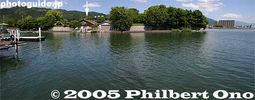
Mihogasaki harbor, Otsu. The arrow points to the boat house.
|
|

Across the road from the Verse 2 song monument is this small music box. Press the button and you can hear the song play (sung by Kato Tokiko).
|
|

Boat house where Taro Oguchi and crew departed on their rowing trip. No longer used by the university's boat club. Mihogasaki, Otsu
|
|

Verse 1 Lyrics (Otsu) 一番の英訳(大津). School logo on boat house, a cherry blossom with three stripes for Dai-san Koto Gakko.We're children of the lake, off to wander 'round.
This journey fills my heart with, intense happiness.
Rising mist evaporates, ripples come and go.
Shiga's Miyako dear, bid farewell for now.
われは湖の子 さすらいの
旅にしあれば しみじみと
のぼる狭霧や さざなみの
志賀の都よ いざさらば
Ware wa Umi no Ko, sasurai no
tabi ni shiareba, shimijimi to
Noboru sagiri ya, sazanami no
Shiga no Miyako yo, iza saraba
--
This first verse refers to the start of the journey of life. The lake mist symbolizes the uncertainty of what lies ahead.
The capital of Shiga is Otsu, where they departed from Mihogasaki boat harbor on June 27, 1917. For some reason, the kanji characters for "Shiga" is incorrect for Shiga Prefecture.
|
|

"Rising mist evaporates, ripples come and go." のぼる狭霧や さざなみの
|
|

Reeds bid rowers farewell for now...
|
|

Rear of boat house, now used by a private boat club.
|
|

Verse 2 Lyrics (Omatsu/Omi-Maiko) 二番の英訳(雄松"Pine trees are very green, on sands very white.
Omatsugasato is, a young maiden's home.
Bush of red camellia, hides her teary face.
She's weeping o'er a lost love, much too short to last.
松は緑に 砂白き
雄松が里の 乙女子は
赤い椿の 森蔭に
はかない恋に 泣くとかや
Matsu wa midori ni, suna shiroki
Omatsugasato no, otomego wa
Akai tsubaki no, morikage ni
Hakanai koi ni, naku toka ya
Omi-Maiko is still famous for white sand beaches and pine trees. In summer these beaches are cluttered with people trying to get a tan.
See more photos of Omi-Maiko here.
|
|

"Pine trees are very green, on sands very white." Omi-Maiko
|
|

White sands of Omi-Maiko (Omatsu), Otsu, Shiga
|
|

Ripples lap white sands of Omi-Maiko.
|
|

Pine trees at Omi-Maiko
|
|

Kyoto University Rowing Club arrive at Omi-Maiko in Aug. 2006 during their annual Lake Biwa rowing trip.
|
|

Omatsu "Famous Place" marker
|
|
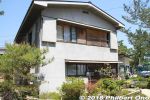
Omatsukan ryokan at Omi-Maiko. This is where Oguchi Taro and rowing mates stayed when they rowed around Lake Biwa. 雄松館
|
|

Song Monument, Imazu. Looks like red fire, but it's also the shape of Imazu town. (The background shows the old Imazu Port building.)Directions: From Omi-Imazu Station on the JR Kosei Line, get out the east exit and walk on the main road toward the lake. You will soon see the Biwako Shuko no Uta Shiryokan song museum on the left. Be sure to visit this museum too. Walk further toward the lake and you will see Imazu Port. Near the water, you can see the "red fire" song monument. On the very end of the pier, and you can see the lamp monument. (The pier might be closed off if there is no boat, so you may have to ask permission to walk on the pier.) Omi-Imazu Station also has a tourist information office where you can obtain directions and a map.
|
|

Song monument at Imazu Port.
|
|
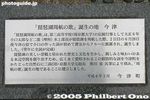
Song Monument plaque, Imazu. It explains about how the song was created in Imazu.
|
|

Imazu Port and song monument in winter snow.
|
|

Chikubushima island and snowly Mt. Ibuki in the background.
|
|

"On shore, we see red fire"Imazu was where the song was born. The town has two monuments for the song. One is the lamp monument built in 1985 on the boat pier (top photo) for Verse 3 (written on the lamp post), and the other is a red stone monument in the shape of a fire dedicated to the entire song. The lamp monument lights up in red at night. The above image was digitally altered.
|
|

"On shore we see red fire, brings back memories." (Imazu)This is the lake beach at Imazu.
See more photos of Imazu here.
|
|

Lake shore at Imazu
|
|

Peninsula where Oguchi Taro and crew departed Imazu. On this peninsula at Imazu, Taro Oguchi and crew departed in their boat for Chikubushima island. The large building is a boathouse that stores two reconstructed fixed-seat boats.
|
|

The large boat house houses two reconstructed fixed-seat boats. This is where Oguchi and crew departed Imazu for Chikubushima.
|
|

Lake waters of Imazu, with Chikubushima and Mt. Ibuki in the distance.
|
|

Nagahama Castle as seen from Lake Biwa. More photos of Nagahama here.The castle tower was reconstructed in 1984.
More photos of Nagahama here.
|
|
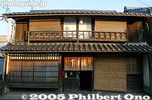
Chojiya ryokan inn, Imazu. This is probably the inn where Taro Oguchi and crew stayed in Imazu and created the song in 1917. 丁子屋It is along the lake shore and still in business today.
It was on June 28, 1917 in Imazu, after dinner on the second day of their rowing trip, when a boatmate named Jiro Nakayasu exclaimed, "Hey everyone, listen up! Oguchi has written this song," and showed everyone the song. Then another boatmate named Taniguchi, who knew a popular song called Hitsuji Kusa (Water Lilies), began singing Oguchi's lyrics to the melody. Since the melody went well with the words, the seven boat crewmates sang the song together that night. It was the birth of the Lake Biwa Rowing Song. The boys worked on the song further and sang it while rowing.
See more photos of Imazu here.
|
|

Chikubushima as seen from Imazu
|
|
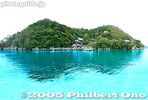
Verse 4 Lyrics (Chikubushima) 四番の英訳(竹生島)Azure blue flower garden, revered coral shrine.
Full of old-time stories, Chikubushima.
In the hands of Buddha, one young maiden lies.
She's sleeping in compassion, resting peacefully.
瑠璃の花園 珊瑚の宮
古い伝えの 竹生島
仏の御手に いだかれて
ねむれ乙女子 やすらけく
Ruri no hanazono, sango no miya
Furui tsutae no, Chikubujima
Hotoke no mite ni, idakarete
Nemure otomego, yasurakeku
Lake Biwa's most famous and sacred island is accessible by boat from Hikone, Nagahama, and Imazu. Color of the water in the photo is not real.
|
|

"Full of old-time stories, Chikubushima."The island has a complex of temples named Hogonji. It belongs to the Shingon Buddhist Sect (Buzan School). It is said that it was first built in 724. It is also the 30th temple in the 33 Temple Pilgrimage of Saigoku (Western Japan).
See more photos of Chikubushima here.
|
|

"Azure blue flower garden, revered coral shrine."
|
|

Chikubushima boat dock. The Verse 4 Song Monument on can be seen on the left.
|
|

Verse 3 Song Monument, Nagahama. Built and unveiled on June 25, 2017 by a non-profit citizens group in Nagahama formed to build this new song monument for the song's 100th anniversary. 三番の歌碑。長浜城のそば�The new Verse 3 Song Monument is near Nagahama Castle near the lake shore. It was unveiled with great fanfare by singer Kato Tokiko and others.
|
|

Buddha statue on Chikubushima
|
|
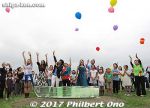
The song monument is made of glass and functions as a park bench for four people. Glassware is one of Nagahama's signature products. Verse 3 is engraved in the middle. It reportedly cost several million yen.After the unveiling, local singers sang the song with Kato Tokiko before everyone released balloons.
|
|

The first people to sit on the song monument. L-R: Nagahama-native Kitagawa Akihiro of the duo ~Lefa~, singer and special guest Kato Tokiko, Kada Yukiko former Shiga governor, and the mayor of Nagahama.
|
|

On June 26, 2017, alumni of the Kyoto University Rowing Club rowed around Lake Biwa and took a break at Nagahama where they sang in front of the new song monument.
|
|

Verse 3 Song Monument at Nagahama's Hokoen Park. It is shaped like a boat and the top has a wavy surface like the water. It is called the "nami-makura" (rolling waves) design.The glass bench is positioned for sunset views over the lake.
Update: Unfortunately, this glass bench monument cracked and was replaced with another bench monument in Sept. 2021.
|
|

Verse 3 Song Monument in Nagahama's Hokoen Park near Nagahama Castle is engraved with Verse 3.浪のまにまに 漂えば
赤い泊火 懐かしみ
行方定めぬ 浪枕
今日は今津か 長浜か
Nami no mani mani, tadayoeba
Akai tomaribi, natsukashimi
Yukue sadamenu, nami makura
Kyo wa Imazu ka, Nagahama ka
|
|

The glass bench actually consists of several glass pieces. A few are largely transparent.
|
|

It's a beautiful design, but quite expensive. The non-profit group was unable to garner enough donations for the monument. They fell far short of the ¥10 million goal.
|
|

Verse 5 Song Monument, Hikone Port 五番の歌碑。彦根港The left stone is inscribed with the entire song, and bigger stone on the right has the lyrics for verse 5. There is also another stone which shows a map of the lake and rowing route. The monument is now encroached by tall grass and weeds.
This song monument was built in Oct. 2005 at a cost of 8 million yen (gathered through donations). With this, now all six verses each have a song monument. This one is next to Hikone Port where you board the boat to visit Chikubushima or Takeshima.
|
|

Close-up of main stone monument where Verse 5 is written. 2005年10月に除幕されて一番新しい歌碑。800万円の寄付金で建てた。Sharp arrows buried deeply, way into the ground.
Abundant summer grasses, a moat still remains.
Standing in an old castle, all alone oneself.
Hira and Ibuki too, only but a dream.
Ya no ne wa, fukaku uzumorete
Natsukusa shigeki, hori no ato
Kojo ni hitori, tatazumeba
Hira mo Ibuki mo, yume no goto
矢の根は 深く埋もれて
夏草しげき 堀のあと
古城にひとり 佇めば
比良も伊吹も 夢のごと
|
|

Verse 5 Song Monument, the third monument showing the rowing route, Hikone PortThe monument's third stone shows a map of the lake and rowing route. It also states the dates when all the song monuments were built in Shiga.
See more photos of Hikone here.
|
|

Verse 5 Song Monument facing Hikone Port. See more photos of Hikone here.The three-stone monument is in a good location facing Hikone Port. This photo was taken soon after the monument was built. Over the years, wild grass or weeds have invaded the monument plot.
|
|

Verse 5 Lyrics (Hikone) 五番の英訳(彦根)Sharp arrows buried deeply, way into the ground.
Abundant summer grasses, a moat still remains.
Standing in an old castle, all alone oneself.
Hira and Ibuki too, only but a dream.
矢の根は 深く埋もれて
夏草しげき 堀のあと
古城にひとり 佇めば
比良も伊吹も 夢のごと
Ya no ne wa, fukaku uzumorete
Natsukusa shigeki, hori no ato
Kojo ni hitori, tatazumeba
Hira mo Ibuki mo, yume no goto
--
This is the only verse where the setting is not specifically mentioned. The only hint is "old castle," which must be either Nagahama Castle or Hikone Castle. It is likely that it is Hikone Castle with its authentic castle tower and moats.
See more photos of Hikone here.
|
|

Verse 6 Song Monument, Chomeiji Port. Built in 1998. 六番の歌碑。長命寺(バス停のすぐそば)Near the Chomeiji bus stop. It faces the pier. This monument has the most number of stones. But only two of them are used.
See more photos of Chomeiji Temple here.
|
|

"Abundant summer grasses, a moat still remains"
|
|

Kyoto University Rowing Club visit the Verse 6 monument during their during their annual Lake Biwa rowing trip. 写真/尾城徹雄Chomeiji is one of their overnight stops during their 3-day rowing trip.
|
|

Main stone of Verse 6 Monument 問題の「西国十番」が刻んでいない。Saigoku pilgrimage, Chomeiji.
Dispel this world's impureness, very faraway.
Golden waves on which we weave, rowing all we can.
Tell us my friends your stories, with your fervent hearts.
Saigoku Juban, Chomeiji
Kegare no utsushiyo, tooku sarite
Kogane no nami ni, iza kogan
Katare wagatomo, atsuki kokoro
西国十番 長命寺
汚れの現世 遠く去りて
黄金の波に いざ漕がん
語れ我が友 熱き心
|
|
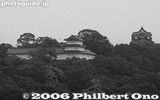
Hikone Castle
|
|

The first verse is wriiten, but the first line about Chomeiji being the 10th temple in the Saigoku Pilgrimage is omitted.Chomeiji is the 31st temple in the Saigoku Pilgrimage, not the 10th temple as sung in the song.
|
|
|
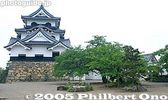
More photos of Hikone Castle here.The castle tower is a National Treasure. Hikone Castle is one of only five castle towers in Japan designated as National Treasures. (The others being Himeji, Inuyama, Matsumoto, and Matsue Castles. Nijo Castle in Kyoto is also a National Treasure, but it does not have a castle tower.)
See more photos of Hikone Castle here.
|
|

Rear of Verse 6 monument. Next to the main stone is a plaque for the entire lyrics.
|
|
|
|

Plaque for entire lyrics, Verse 6 Song Monument, ChomeijiJapanese lyrics of the entire song consisting of 6 verses.
|
|
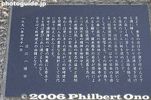
Message plaque, Verse 6 Song Monument, Chomeiji
|
|

Verse 6 Song Monument facing Chomeiji pier
|
|

Verse 6 Song Monument, Chomeiji Temple. Built in Nov. 2011.Directions: From Omi-Hachiman Station on the JR Biwako Line, take a bus to Chomeiji. Takes about 20 min. Omi-Hachiman Station has a tourist information office where you can obtain directions and a map. You can also rent a bicycle at the station and follow the map to Chomeiji Port. The monument is in a small park in front of the port near the Chomeiji bus stop. The other Verse 6 monument is within the Chomeiji temple grounds. Climb the 800 steps (quite strenuous) to the temple or call a taxi to drive up near the top.
|
|

Verse 6 Lyrics (Chomeiji) 六番の英訳(長命寺)Saigoku pilgrimage, Chomeiji.
Dispel this world's impureness, very faraway.
Golden waves on which we weave, rowing all we can.
Tell us my friends your stories, with your fervent hearts.
西国十番 長命寺
汚れの現世 遠く去りて
黄金の波に いざ漕がん
語れ我が友 熱き心
Saigoku Juban, Chomeiji
Kegare no utsushiyo, tooku sarite
Kogane no nami ni, iza kogan
Katare wagatomo, atsuki kokoro
--
This verse is said to refer to the Pure Land of Buddhism. The song has strong Buddhist overtones, but interestingly the melody happens to be based on a Christian hymn. Chomeiji was a lunch stop before they rowed back to Otsu.
See more photos of Chomeiji Temple here.
|
|

Donated by Omi-Hachiman resident Fukao Katsuyoshi and unveiled on Nov. 5, 2011.
|
|

Unlike the song monument at Chomeiji Port, this monument includes the first line of Verse 6 with the mistaken "Saigoku Pilgrimage 10th temple."
|
|

"Saigoku pilgrimage, Chomeiji."
|
|

The monument is in a very good location within the Chomeiji temple grounds. All temple visitors have to pass by the monument. It also overlooks the lake.
|
|

Chomeiji, 31st temple on the Saigoku Pilgrimage Circuit
|
|
|

"Dispel this world's impureness, very faraway."
|
|

Stone monument for Verse 6
|
|

"Golden waves on which we weave..."
|
|

Golden waves
|
|

Regatta on Lake Biwa
|
|
|

"Tell us my friends your stories, with your fervent hearts."
|
|

Biography of Oguchi Taro
|
|

Printable map and directions to all song monuments. Google map 歌碑の案内地図Also see this Google map: Google map
|
|

About Taro Oguchi.The song was written as a collaboration among boatmates, but Taro Oguchi (小口太郎) (1897-1924) is credited as being the main song writer. He was born in 1897 (Meiji 30) in Minato-mura village, now part of Okaya city on the shores of Lake Suwa in Nagano Prefecture.
He grew up in a loving and respected family and demonstrated an early talent for writing, music (violin and shakuhachi), and sports (judo, skiing, skating). Since he was the eldest son expected to take over the family home, there was opposition for him to go away for college. However, his father was persuaded to allow Taro to apply for college at the elite No. 3 High School (later to become Kyoto University). It was one of nine college-level schools in Japan, the No. 3 school being one of the most elite.
Contrary to family expectations, Taro passed the entrance exam, went school in Kyoto in 1914 and joined the rowing and speech clubs. In 1917, he wrote the famous song about Lake Biwa which first went public in 1918.
After the rowing trip in June 1917, school started in September and they had the usual student welcoming event where the school clubs would try to recruit new members. The music club gave a performance and boatmate Taniguchi (who suggested the Water Lilies melody for the song) also sang the Lake Biwa Rowing Song. He had such a beautiful voice that the boating club got several new members who were taken by the song. However, they quickly regretted joining the rowing club after being subjected to harsh training and practice.
The song itself was never considered to be a masterpiece by the boating members, even Oguchi himself. It was just a dormitory song written informally. For example, there's the famous error about calling Chomeiji the 10th Temple of the Saigoku Pilgrimage when it is actually the 31st temple. None of the rowing members ever told their family about the song either. Oguchi's parents found out that their son wrote the song only after he had passed away.
Oguchi also wanted to use a different melody for his words, a song called "Nara no Miyako" 寧良の都. It is obvious that this song melody was too long for his lyrics, but since he had musical composition talents, it looked easy to slightly modify the song to fit the lyrics perfectly. Alas, this was not to be as the song gained much love and fame while being based on the Water Lilies melody.
He graduated in 1919 and furthered his studies at Tokyo Imperial University (now University of Tokyo) in the science department. In 1921, he invented the wired and wireless multiplex telegraph and telephone system which was patented in eight countries. He was an extremely bright young man with a promising future.
In 1922, he entered the university's aeronautical research institute as a researcher. However, his life soon took a downturn from 1923 when he received a military conscription notice. A love interest for marriage also did not work out as desired. His physical health deteriorated and he died the following year in 1924 at age 26.
|
|

Biwako Shuko no Uta Birthplace Monument, Imazu. This is Imazu's second monument for the song. 全歌詞碑の「琵琶湖周航の歌」誕生の地 今津。今津港。背景には竹生島行きの船。Imazu has two monuments for the song. The first one is a lamp at the end of the pier (visible in this picture on the right of the boat). That was for Verse 3 which is written on the lamp post.
Later in 1994, Imazu town built this red clay monument to commemorate the song's birth in Imazu. The entire lyrics is also engraved. It is next to the Imazu boat pier where boats depart for Chikubushima. Looks like a red flame, but it's shaped after the geographical shape of Imazu town.
From Imazu, you can easily go to Chikubushima island, from which you can take another boat to go to Hikone or Nagahama. Going vice versa is possible too. It's a great way to cross the lake.
See more photos of Imazu here.
|
|

Old Imazu Port. Notice the "red flame" song monument on the right.
|
|

The old Biwako Shuko no Uta Shiryokan (Lake Biwa Rowing Song Museum), Imazu 琵琶湖周航の歌資料館、今津町This museum dedicated to this song opened in April 1998 in Imazu. It is a 3-min. walk from Omi-Imazu Station on the JR Kosei Line. Closed in March 2020 and moved to a new building.
Hours: 9 am to 5 pm, closed Mon. (open if Mon. is a national holiday, and closed on Tue. instead)
Free admission.
|
|

Model of fixed-seat boat used during Oguchi Taro's time in 1917.Model of the fixed seat boat that Taro Oguchi and crew used to row around Lake Biwa. Displayed at the song museum in Imazu. The boat is quite stable and thus suited for long rowing trips. However, it became obsolete in the 1960s as competitive rowing boats incorporated sliding seats.
In 1993, a boat craftsman built two of these and donated them to Imazu. They measure 13.7 meters long and 1.25 meter wide. Seats 6 crew. They are available for rent at Imazu.
|
|

Model of fixed-seat boat, Biwako Shuko no Uta Shiryokan museum
|
|

Model of fixed-seat boat
|
|

Biwako Shuko no Uta Shiryokan (Lake Biwa Rowing Song Museum), Imazu 琵琶湖周航の歌資料館The museum has various panel exhibits, videos, etc. Currently, no explanations in English. Tokiko Kato scored a national hit with the song in 1971.
|
|

Biwako Shuko no Uta Shiryokan (Lake Biwa Rowing Song Museum), Imazu 琵琶湖周航の歌資料館
|
|

Listening corner list of cover artists. There are many, and you can listen to each of them. Biwako Shuko no Uta Shiryokan (Lake Biwa Rowing Song Museum), ImazuThe song was included in a record for the first time in 1958 when Kyoto University made an album of its university songs on the 90th anniversary of the school's founding. In 1961, a chorus group named Boney Jacks recorded the song in an album of Japanese songs. And so did singer Peggy Hayama in 1962.
|
|

Panel exhibits of each verse.
|
|

Panel showing Japanese lyrics, old and new. Biwako Shuko no Uta Shiryokan, ImazuOne of the exhibition panels with the song lyrics showing all the little quirks and idiosyncrasies of the words. This is the first verse.
|
|

Oguchi Taro exhibit.
|
|
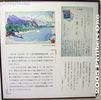
Handpainted postcard from Taro Oguchi mailed from Imazu on June 28, 1917.During the rowing trip, Oguchi wrote a postcard to a friend back at the school dorm in Kyoto. One side of the card has his watercolor painting of Omatsu with pine trees on the sandy beach and a boat pier. Oguchi was quite good at painting.
Oguchi sent the postcard from Imazu on June 28, 1917, in the evening sometime between 9 pm and midnight after arriving from Omatsu. He sent it to a friend named Hiroshi Kodama back at the school dorm in Kyoto. However, the friend never received the postcard since he was back in his hometown in Niigata Prefecture for the summer.
The postcard was returned to Oguchi who kept it. If his friend had received the postcard, he would have certainly thrown it away (as he later mentioned in an interview). This postcard has survived miraculously and it is key evidence for the exact date when they were in Imazu where the song was created.
On the postcard, Oguchi writes about how easy it was to row to Omatsu the day before, thanks to a strong tailwind. He notes that Omatsu was a lonely place with only one lodge. They tied up the boat in the pond and rolled around on the sand till late night while gazing at the moon and dreaming of a beautiful girl. That morning, they played tug of war (it was fun). He also mentions that they were to lodge in Imazu that night.
|
|

Old records by famous Japanese singers and groups who covered the song.
|
|
|
|